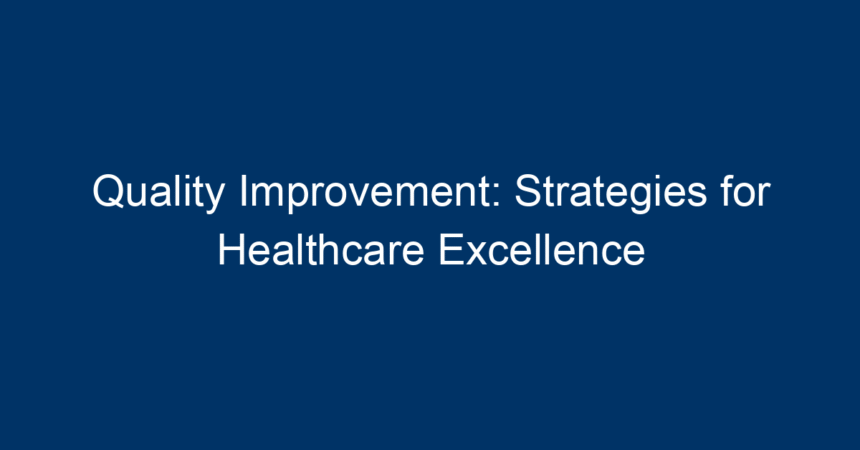In today’s fast-paced healthcare environment, the pursuit of excellence is more critical than ever. Quality improvement (QI) is the systematic approach used by healthcare organizations to enhance patient outcomes, streamline processes, and elevate overall care standards. This article delves into comprehensive strategies for quality improvement in healthcare that can lead to transformative results for both providers and patients.
Understanding Quality Improvement
What is Quality Improvement?
Quality improvement refers to the ongoing efforts to enhance patient services and healthcare systems by identifying areas for improvement, implementing changes, and monitoring their effectiveness. This multidimensional approach focuses on elevating care not only through efficiency but also through patient safety, satisfaction, and outcomes.
Importance of Quality Improvement in Healthcare
The importance of quality improvement cannot be overstated. As healthcare costs continue to rise and patient expectations increase, organizations must adopt QI strategies to stay competitive and compliant. By committing to quality improvement, healthcare facilities can:
- Enhance Patient Safety: Reducing errors and improving the overall safety of medical practices is paramount.
- Increase Efficiency: Streamlining processes can lower costs and eliminate redundancies.
- Boost Patient Satisfaction: High-quality care fosters patient loyalty and positive outcomes.
- Meet Regulatory Standards: Compliance with laws and guidelines is essential for any healthcare organization.
Key Strategies for Quality Improvement in Healthcare
1. Establish Clear Goals and Objectives
Effective quality improvement begins with well-defined goals. By setting measurable objectives, healthcare organizations can direct their QI efforts to specific problem areas. Use the SMART criteria (Specific, Measurable, Achievable, Relevant, Time-bound) for goal-setting to ensure clarity and focus.
2. Engage Leadership and Staff
Successful quality improvement requires buy-in from all levels of the organization. Leadership must not only endorse initiatives but also participate actively. Engaging staff in the process fosters collaboration, cultivates a culture of quality, and encourages shared accountability.
3. Implement Evidence-Based Practices
Evidence-based practice is critical to enhancing quality improvement initiatives. By relying on proven research and data rather than tradition or anecdote, healthcare providers can ensure that their interventions yield favorable outcomes. Regular training and workshops can help familiarize staff with the latest research findings and best practices.
4. Utilize Data for Informed Decision-Making
Data collection and analysis form the backbone of quality improvement. By utilizing electronic health records (EHR) and other metrics, healthcare organizations can monitor performance indicators, patient outcomes, and areas needing improvement. Key performance indicators (KPIs) should be tracked consistently to gauge progress.
5. Foster a Culture of Continuous Improvement
Creating an environment that encourages continuous improvement among staff can significantly impact quality outcomes. This involves training employees to embrace feedback, learn from mistakes, and pursue innovative solutions. A supportive atmosphere that recognizes efforts can drive motivation and commitment to ongoing quality improvement.
6. Engage Patients in Their Care
Patient engagement is crucial for successful quality improvement. Educating patients about their conditions and involving them in care decisions can lead to better adherence and outcomes. Utilize feedback mechanisms such as surveys, focus groups, and patient advisory councils to gather insights directly from those receiving care.
7. Utilize Quality Improvement Frameworks
Several established frameworks guide organizations through the QI process. The Plan-Do-Study-Act (PDSA) cycle, for example, encourages test-and-learn experimentation, allowing healthcare organizations to implement changes on a small scale before widespread application. The Six Sigma and Lean methodologies also offer structured approaches to enhance quality and reduce waste.
Measuring Success in Quality Improvement
Key Performance Indicators (KPIs)
Tracking KPIs is essential to measure the success of quality improvement initiatives. Common KPIs include:
- Patient Satisfaction Rates: Surveys and feedback can gauge the effectiveness of care.
- Readmission Rates: High rates may indicate areas needing improvement.
- Infection Rates: Monitoring these can identify potential quality gaps in practices.
- Response Times: Timeliness in treatment and services is a significant determinant of care quality.
Conduct Regular Audits
Regular audits of processes and outcomes can provide valuable insights into the effectiveness of quality improvement efforts. These audits should analyze data on patient outcomes, compliance with protocols, and staff performance, ensuring that interventions continue to meet established goals.
Overcoming Challenges in Quality Improvement
While the road to quality improvement can be challenging, it can be navigated successfully with strategic planning. Common barriers include:
- Resistance to Change: Change management strategies are critical to overcome fear and reluctance.
- Limited Resources: Prioritizing projects and seeking external funding or partnerships can alleviate resource constraints.
- Inconsistent Data Collection: Standardizing data collection processes ensures accuracy and reliability.
Actionable Insights for Implementing Quality Improvement
- Train Staff Regularly: Continuous education on QI principles ensures everyone understands their role.
- Communicate Clearly: Share progress and challenges with staff to maintain transparency and foster trust.
- Celebrate Successes: Recognizing and rewarding achievements encourages a culture of quality and motivates teams.
- Continuously Adapt: Quality improvement is an ongoing journey; organizations should be prepared to pivot based on data and feedback.
Conclusion
Quality improvement in healthcare is essential for achieving excellence in patient care. By establishing clear objectives, engaging leadership and staff, relying on data, and fostering a culture of continuous improvement, healthcare organizations can create a robust framework for success. Through evidence-based practices and patient engagement, the healthcare community can enhance outcomes, boost efficiency, and elevate the standard of care.
By embracing these quality improvement strategies, healthcare providers not only meet compliance standards but can achieve excellence that ultimately benefits patients and society at large. The journey toward quality improvement is ongoing, but with commitment and strategic action, healthcare organizations can navigate the path to excellence effectively.




